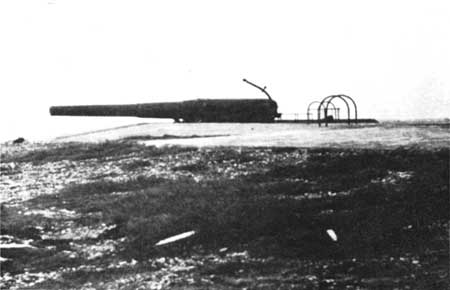|
FORT SUMTER National Monument |
 |

One of the 12-inch guns of Battery Huger, as mounted in 1901.
Fort Sumter After
1865
In the 1870's the rubble and ruin of war were cleared from the interior of Fort Sumter, and the work of reconstruction began. The outer walls of the gorge and right flank, largely destroyed by the bombardments, were partially rebuilt. The other walls of the fort, left jagged and torn 30 to 40 feet above water, were leveled to approximately half their original height. Through the left flank a new sally port was constructed. Within the reconstructed walls of the fort, the earth and concrete works for a 10-gun battery en barbette (guns fired from an open parapet) began to take shape.
Operations were well advanced, when, in June 1876, shortage of funds forced complete suspension of activity. Only three permanent barbette platforms had been constructed by that time. Of necessity, seven temporary (wooden) platforms remained; on these, four "200 pounder" Parrott rifles and two 15-inch Rodman smoothbores had been mounted. In a modification of the original plan, 11 lower-tier gunrooms of the original fort along the right face and about the salient had been recovered and armed with "100 pounder" Parrotts. In a gradually deteriorating state, these 17 guns constituted Fort Sumter's armament for the next 23 years.
From 1876 to 1898, Fort Sumter stood largely neglected, important mainly as a lighthouse station. Ungarrisoned, most of that time it was in the charge of a "fortkeeper" or an ordnance sergeant. Without proper funds for maintenance, Fort Sumter, even then visited by thousands each year, fell into a state of dilapidation. By 1887 the wooden platforms of the barbette guns had rotted away so that "not one gun could be safely fired"; the neat earth slopes had eroded into "irregular mounds"; and quantities of sand had drifted into the parade ground. The casemate guns rusted so that they could not be traversed; salt water dashed freely through the open embrasures, the shutters of which were no longer in working order.
The Spanish-American War, 1898, prompted the construction in 1899 of a battery of two long-range rifled cannon at Fort Sumter. The massive concrete emplacement for this battery (named for Isaac Huger, South Carolinian, general in the American Revolution) dominates the central portion of Fort Sumter today. The guns, long since outmoded, were removed about 1941. During World War II, Fort Sumter was armed with 90-mm. antiaircraft guns manned by a garrison of Coast Artillery.

|
|
Last Modified: Mon, Dec 2 2002 10:00:00 am PDT |


